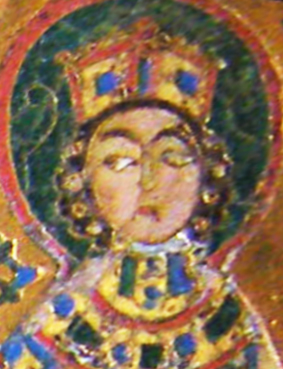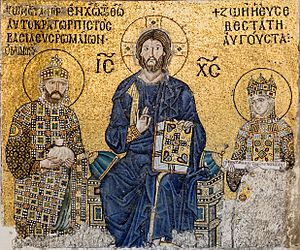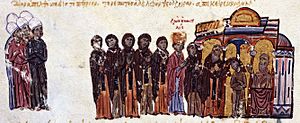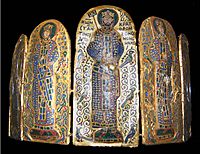Theodora Porphyrogenita facts for kids
Quick facts for kids Theodora Porphyrogenita |
|
|---|---|
| Empress and Autocratess of the Romans | |

Theodora in the Monomachus Crown
|
|
| Byzantine empress regnant | |
| Reign | 21 April 1042 – 31 August 1056 |
| Coronation | 21 April 1042 |
| Predecessor | Michael V |
| Successor | Michael VI |
| Co-regent | Zoë (1042–1050) Constantine IX (1042–1055) |
| Born | c. 980 Constantinople (now Istanbul, Turkey) |
| Died | 31 August 1056 (aged 75–76) Constantinople |
| Burial | Church of the Holy Apostles, Constantinople |
| Dynasty | Macedonian |
| Father | Constantine VIII |
| Mother | Helena |
Theodora Porphyrogenita (Greek: Θεοδώρα Πορφυρογέννητη, Theodōra Porphyrogenítē; c. 980–31 August 1056) was a powerful Byzantine Empress. She ruled the Byzantine Empire from April 21, 1042, until her death on August 31, 1056. For the last 16 months of her reign, starting January 11, 1055, she ruled all by herself. Theodora was part of the Macedonian dynasty, a family that led the Byzantine Empire for almost 200 years.
Theodora became involved in politics later in her life. Her father, Constantine VIII, was a co-ruler of the Byzantine Empire for 63 years. He then ruled alone from 1025 to 1028. After he passed away, Theodora's older sister, Zoë, ruled with her husbands and later with her adopted son, Michael V. During this time, Theodora was watched very closely. After being accused of two plots, Theodora was sent away to a monastery on an island in the Sea of Marmara in 1031.
About ten years later, the people of Constantinople rebelled against Michael V. They demanded that Theodora return to rule alongside her sister Zoë. After 65 days, Zoë married again, this time to Constantine IX, who took over the main imperial duties. Theodora seemed to step back from public life after Zoë died in 1050. However, when Constantine died, 74-year-old Theodora returned to the throne. She faced strong opposition from court officials and military leaders. For 16 months, she ruled as empress on her own before she became suddenly ill and died at the age of 76. She was the last ruler from the Macedonian family line.
Contents
Theodora's Early Life and Family
Theodora was the third and youngest daughter of the Byzantine Emperor Constantine VIII and Helena, daughter of Alypius. She was known as Porphyrogenita, which means "born into the purple." This special title was given to children born in the capital city to a ruling emperor. Her father became a co-emperor in 962 and then the sole emperor after his brother Basil II died in 1025. His time as the only emperor lasted less than three years, from December 15, 1025, to November 12, 1028.
As a princess, Theodora was considered as a possible bride for the Holy Roman Emperor in the west, Otto III, in 996. However, her sister Zoë was chosen instead. Otto III died before any marriage could happen. Theodora's uncle, Basil II, did not allow his nieces to marry any Byzantine nobles. He worried that such a marriage would give their husbands a claim to the imperial throne. Since women like Theodora and Zoë could not rule on their own, their only way to have power was by marrying someone who would then gain authority. Because of this, Theodora lived a quiet life in the imperial gynaeceum (the women's quarters).
Theodora was smart and had a strong, serious personality. When her father, Constantine VIII, was the sole emperor, he wanted her to marry Romanos Argyros to become his successor. But Theodora refused. She said that Romanos was already married (his wife had become a nun so he could marry into the imperial family). Theodora also said that she and Romanos were third cousins, which was too close a blood relationship for marriage. So, Constantine VIII chose Theodora's sister, Zoë, instead. Zoë married Romanos just three days before her father died.
After Romanos became emperor, Theodora wisely went back to the gynaeceum and its daily religious routines. Still, Zoë convinced her husband to put one of his own men in charge of Theodora's household to spy on her. Soon after, Theodora was accused of planning to marry the Bulgarian prince Presian and take the throne with him. Presian was blinded and sent to a monastery, but Theodora was not punished. In 1031, she was involved in a similar plot with Constantine Diogenes. Theodora was then forced to live in the monastery of Petrion. During a visit, Zoë made her sister take Holy Orders (become a nun). Theodora stayed there for the next 11 years while Zoë managed the empire with her husbands, Romanos III and, after his death, Michael IV.
Theodora as Co-Empress with Zoë
When Michael IV died in December 1041, Zoë adopted Michael's nephew, who was crowned as Michael V. He promised to respect Zoë, but he quickly sent her away to a monastery on the Princes' Islands. He accused her of trying to kill him. This treatment of the rightful heir to the Macedonian family caused a large uprising in Constantinople. On April 19, 1042, the people rebelled against Michael V. They supported not only Zoë but also Theodora. Michael V, desperate to keep his throne, first brought Zoë back from Princes' Island and showed her to the people. But the people did not want him to continue ruling with Zoë.
Important people at court decided that Zoë needed a co-ruler. They supported the people's demand that it should be Theodora. A group, led by the patrician Constantine Cabasilas, went to the monastery at Petrion to convince Theodora to become co-empress. Theodora, who was used to a quiet life of religious thought, refused their requests at first. She even ran to the convent chapel to find safety. Constantine and his group followed her, pulled her out, and changed her monastic clothes for imperial ones. At a gathering at Hagia Sophia, the people escorted the now very angry Theodora and declared her empress with Zoë. They were both crowned at dawn on April 21. After the ceremony, the crowd stormed the palace, forcing Michael V to escape to a monastery.
Zoë immediately took power and tried to send Theodora back to her monastery. But the Senate and the people demanded that the two sisters rule together. Theodora's first task was to deal with Michael V. Zoë, who was weak and easily influenced, wanted to forgive and free Michael. But Theodora was much stricter. She first promised Michael's safety, then ordered that he be blinded and spend the rest of his life as a monk. After Michael V was dealt with, Theodora refused to leave Hagia Sophia until she received a formal invitation from Zoë, about 24 hours after they had been crowned. Officially, Theodora was the junior empress, and her throne was placed slightly behind Zoë's at all public events. But in reality, she was the main force behind their shared rule. The sisters managed the empire, focusing on stopping the sale of public offices and on making sure justice was fair. While some historians said their joint rule was a failure, others stated that they worked hard to fix the problems from earlier reigns.
Even though Theodora and Zoë appeared together at Senate meetings and public audiences, it soon became clear that their shared rule was difficult. Zoë was still jealous of Theodora. She did not want to manage the empire herself, but she also would not let Theodora handle public business alone. Different groups at court formed, supporting one empress or the other. After two months of growing arguments between them, Zoë decided to find a new husband. This would stop Theodora from gaining more influence with her clear talent for governing. Zoë eventually married Constantine IX on June 11, 1042, and he took over the management of the empire. Although Theodora and Zoë were still recognized as empresses and Theodora continued to appear at all official events, the real power went to her brother-in-law. Still, Theodora had influence at court. For example, she ordered the arrest and blinding of John the Eunuch, a powerful administrator who had been a chief minister in earlier reigns.
Constantine IX's special treatment of his mistress early in his reign led to rumors that he planned to murder Theodora and Zoë. This caused a public uprising by the people of Constantinople in 1044. It came dangerously close to harming Constantine, who was taking part in a religious parade. The crowd only calmed down when Zoë and Theodora appeared on a balcony, assuring them that they were safe.
Theodora's Return to Power

After Zoë died in 1050, Theodora seems to have gone back to a convent. Constantine IX then ruled alone until his own death on January 11, 1055. As Constantine was dying, his advisors, especially the logothetes tou dromou John, convinced him to ignore Theodora's rights. They wanted him to pass the throne to Nikephoros Proteuon, the doux (Duke) of the Byzantine region of Bulgaria. However, Theodora acted quickly. Despite her old age, she strongly claimed her right to rule. She came out of retirement and called a meeting of the Senate. The imperial guard then declared her "emperor" shortly before Constantine died.
After this, Theodora removed many senior officials and military leaders from their positions. Nikephoros Bryennios, whom some western military groups apparently wanted to make emperor, was dismissed and sent away by Theodora's orders. She then took his properties and banished his supporters from court.
Theodora kept the nobles in check and stopped many unfair practices. However, she sometimes harmed her reputation by being too harsh towards her personal enemies. She also relied too much on less important people like Leo Paraspondylos as her advisors. Military and court positions were filled by her household eunuchs. Talented commanders like Isaac Komnenos were replaced with minor officials. Determined to keep as much power as possible for herself, she personally led meetings in the Senate and heard appeals as the highest judge in civil cases. Her choices for religious leaders upset the Patriarch Michael Keroularios, who believed this was a duty for men, not women.
When Theodora was 76, Patriarch Michael Keroularios suggested that she should choose someone to rule by marrying them. This would ensure a clear successor. She refused to consider marriage, even a symbolic one. She also refused to name an heir to the throne. Theodora became very ill with a stomach problem in late August 1056. On August 31, her advisors, led by Leo Paraspondylos, met to decide who to suggest as her successor. According to a historian named Psellus, they chose Michael Bringas. He was an old civil servant and former military finance minister. His main appeal was that "he was less qualified to rule than he was to be ruled and directed by others." Theodora was unable to speak, but Paraspondylos decided that she had nodded at the right moment. Hearing this, the Patriarch did not believe it at first. Eventually, he was convinced, and Bringas was crowned as Michael VI. Theodora died a few hours later. With her death, the Macedonian dynasty's 189-year rule came to an end.
|
See also
 In Spanish: Teodora Porfirogéneta para niños
In Spanish: Teodora Porfirogéneta para niños




